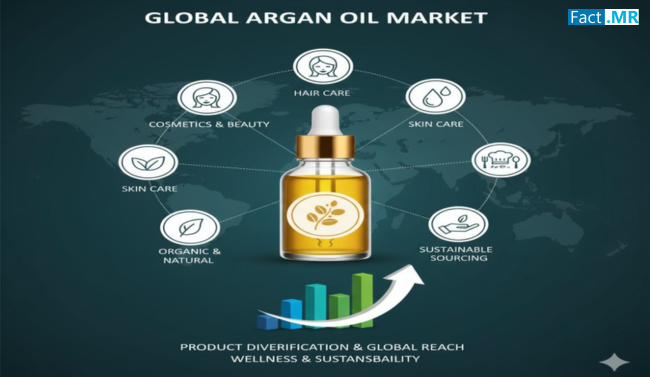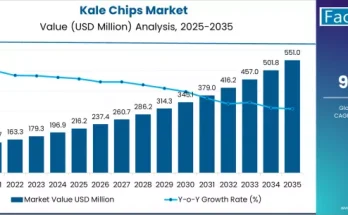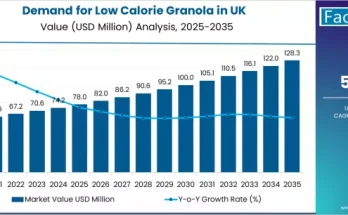The global argan oil market has witnessed remarkable growth in recent years, driven by rising consumer awareness of natural and organic products, particularly in the personal care, cosmetics, and food industries. Extracted from the kernels of the argan tree, argan oil is celebrated for its rich nutritional profile, antioxidant properties, and versatile applications ranging from hair and skincare to culinary uses. With the demand for natural alternatives rising, argan oil has become a premium ingredient sought after worldwide.
This article provides a comprehensive analysis of the argan oil market, covering growth drivers, trends, regional insights, consumer behavior, challenges, and opportunities for both established companies and new entrants.
Market Overview
Argan oil is available in various forms, including pure, blended, and concentrated formulations. The market also differentiates products by grade—cosmetic and culinary—and by nature, including organic and conventional options. Packaging formats range from bulk B2B supplies to consumer-ready B2C packaging, catering to diverse end-use industries.
The cosmetic and personal care segment dominates the market due to argan oil’s properties that enhance skin and hair health. Meanwhile, culinary applications are expanding as consumers increasingly use argan oil for cooking, flavoring, and incorporating it into gourmet food products. The global shift toward natural, chemical-free products has accelerated the adoption of argan oil in both personal care and food applications.
Key Market Drivers
- Rising Popularity in Cosmetics and Personal Care
Argan oil’s moisturizing, anti-aging, and anti-inflammatory properties have made it a staple ingredient in shampoos, conditioners, skin creams, serums, lip balms, and essential oils. Brands like Sephora, L’Oréal, and Lakmé have incorporated argan oil into premium skincare and haircare products. The growth of men’s grooming products, including beard oils, hair waxes, and shower gels, also contributes to market expansion.
- Increasing Consumer Awareness
Consumers are becoming more informed about the benefits of argan oil compared to synthetic alternatives. Awareness of its antioxidant properties, vitamin E content, and natural composition drives the preference for argan oil in both skincare and culinary applications.
- Expansion in Food & Beverage Applications
Argan oil is increasingly used in snacks, frozen desserts, confectionery, and gourmet dishes. Its unique flavor profile and nutritional benefits appeal to health-conscious consumers seeking high-quality oils for cooking and finishing dishes.
- Preference for Organic and Natural Products
Organic and natural ingredients are driving demand in both cosmetic and food sectors. Consumers are increasingly avoiding chemical-based products, turning toward argan oil for its natural properties and traceable sourcing.
- Technological Advancements in Production
Modern extraction methods, including mechanical and cold-press techniques, have improved production efficiency while maintaining high oil quality. These innovations enable manufacturers to meet rising demand without compromising product integrity.
Market Challenges
- Adulteration and Quality Concerns
The market faces challenges from adulterated products and inappropriate labeling. Low-cost oils such as sunflower or other vegetable oils are sometimes mixed with argan oil, reducing quality and consumer trust. Ensuring purity and authenticity remains a critical concern.
- Dependence on Traditional Processing
Many producers still rely on labor-intensive manual extraction methods, limiting productivity and efficiency. While mechanical processes exist, they are not yet widely adopted in certain regions, affecting supply scalability.
- High Production Costs
Organic and cosmetic-grade argan oil production requires careful processing and sourcing, which increases costs. This can make products less affordable in price-sensitive markets.
- Regulatory and Certification Barriers
Stringent regulations, quality certifications, and labeling requirements can pose challenges, particularly for exporters aiming to access multiple international markets.
Regional Insights
North America
North America is a key market due to high consumer awareness of natural cosmetics, organic ingredients, and personal care trends. Aromatherapy and wellness-driven products featuring argan oil are increasingly popular. Consumers prioritize quality, traceability, and ethically sourced oils, driving growth in premium cosmetic and edible argan oil segments.
Europe
Europe is a significant market, with strong demand for organic and natural products in countries like Germany, France, and the UK. Consumers value sustainability, clean-label certifications, and ethically sourced ingredients. Functional beauty products and gourmet culinary oils drive demand in the region.
Asia-Pacific
The Asia-Pacific region is witnessing steady growth as consumers adopt premium skincare and haircare products. Countries such as Japan, South Korea, and India show increasing interest in natural cosmetics. The food sector also drives adoption as culinary enthusiasts explore premium cooking oils.
Middle East & Africa
The Middle East & Africa region, particularly Morocco, is central to argan oil production. Morocco supplies a significant portion of the global market, with large-scale cultivation and export capabilities. The region benefits from both production capacity and rising local consumption driven by natural beauty trends.
Country Insights
Morocco
Morocco is the primary producer of argan oil, producing thousands of tons annually, with the majority exported. The country has a long-standing tradition of argan oil extraction and is a central hub for global supply.
Israel
Israel has increased its agricultural production capacity to meet global demand. Investments in argan cultivation and processing allow the country to supplement international supply and serve growing regional markets.
Consumer Trends
- Natural Beauty Focus: Increased demand for chemical-free skincare and haircare products featuring argan oil.
- Organic Food Adoption: Consumers prefer argan oil in cooking and gourmet applications for its flavor and health benefits.
- Premiumization: Consumers are willing to pay higher prices for high-quality, authentic, and ethically sourced argan oil.
- Men’s Grooming Products: Rising use of argan oil in beard oils, hair waxes, and skin care for men.
- E-commerce Sales: Online platforms facilitate direct consumer purchases and subscription-based models, enhancing accessibility.
Competitive Landscape
Key players in the argan oil market include:
- Beauty Quest Group
- Inspired Beauty Brands
- Sivan SM
- Earthly Body
- Cooperative Toudarte
Companies are investing in expanding production capacities, strengthening distribution channels, and developing value-added cosmetic and edible products. Strategic partnerships, certification initiatives, and marketing campaigns are helping players build brand credibility and attract premium consumers.
Opportunities for New Entrants
New players can capitalize on growing demand by:
- Introducing organic, cold-pressed, and cosmetic-grade oils
- Targeting niche markets in men’s grooming and natural beauty products
- Offering culinary oils with unique flavors and premium positioning
- Leveraging e-commerce and direct-to-consumer strategies
- Implementing sustainability and ethical sourcing practices
Innovation, branding, and quality assurance are key factors for success in this competitive market.
Future Outlook
The argan oil market is poised for sustained growth, driven by rising awareness of natural and organic products. Factors influencing future growth include:
- Increased adoption in skincare, haircare, and grooming products
- Expansion into functional and gourmet culinary applications
- Enhanced production efficiency through modern extraction methods
- Global demand from North America, Europe, and Asia-Pacific
- Emphasis on ethical sourcing, sustainability, and organic certifications
As consumer preferences continue to favor authenticity, premium quality, and natural ingredients, the argan oil market is expected to remain dynamic and profitable in the coming decade.
Conclusion
Argan oil has established itself as a premium ingredient in cosmetics, personal care, and culinary applications. The market is driven by consumer demand for natural, organic, and sustainable products, as well as the growing popularity of premium grooming and skincare items. While challenges like adulteration, production costs, and regulatory compliance exist, opportunities in functional products, gourmet oils, and e-commerce distribution present strong growth potential.
By focusing on quality, innovation, and consumer engagement, stakeholders can capitalize on the expanding global argan oil market and secure long-term success.


